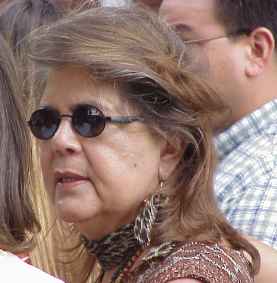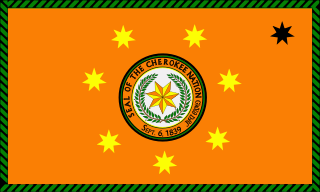
The Indian Reorganization Act (IRA) of June 18, 1934, or the Wheeler–Howard Act, was U.S. federal legislation that dealt with the status of American Indians in the United States. It was the centerpiece of what has been often called the "Indian New Deal".
The Mashantucket Pequot Tribal Nation is a federally recognized American Indian tribe in the state of Connecticut. They are descended from the Pequot people, an Algonquian-language tribe that dominated the southern New England coastal areas, and they own and operate Foxwoods Resort Casino within their reservation in Ledyard, Connecticut. As of 2018, Foxwoods Resort Casino is one of the largest casinos in the world in terms of square footage, casino floor size, and number of slot machines, and it was one of the most economically successful in the United States until 2007, but it became deeply in debt by 2012 due to its expansion and changing conditions.

The term Five Civilized Tribes was applied by the United States government in the early federal period of the history of the United States to the five major Native American nations in the Southeast: the Cherokee, Chickasaw, Choctaw, Muscogee (Creek), and Seminoles. White Americans classified them as "civilized" because they had adopted attributes of the Anglo-American culture.

The Bureau of Indian Affairs (BIA), also known as Indian Affairs (IA), is a United States federal agency within the Department of the Interior. It is responsible for implementing federal laws and policies related to Native Americans and Alaska Natives, and administering and managing over 55,700,000 acres (225,000 km2) of reservations held in trust by the U.S. federal government for indigenous tribes. It renders services to roughly 2 million indigenous Americans across 574 federally recognized tribes. The BIA is governed by a director and overseen by the Assistant Secretary for Indian Affairs, who answers to the Secretary of the Interior.

Wilma Pearl Mankiller was a Native American activist, social worker, community developer and the first woman elected to serve as Principal Chief of the Cherokee Nation. Born in Tahlequah, Oklahoma, she lived on her family's allotment in Adair County, Oklahoma, until the age of 11, when her family relocated to San Francisco as part of a federal government program to urbanize Indigenous Americans. After high school, she married a well-to-do Ecuadorian and raised two daughters. Inspired by the social and political movements of the 1960s, Mankiller became involved in the Occupation of Alcatraz and later participated in the land and compensation struggles with the Pit River Tribe. For five years in the early 1970s, she was employed as a social worker, focusing mainly on children's issues.

The United Keetoowah Band of Cherokee Indians in Oklahoma is a federally recognized tribe of Cherokee Native Americans headquartered in Tahlequah, Oklahoma. According to the UKB website, its members are mostly descendants of "Old Settlers" or "Western Cherokees," those Cherokees who migrated from the Southeast to present-day Arkansas and Oklahoma around 1817. Some reports estimate that Old Settlers began migrating west by 1800, before the forced relocation of Cherokees by the United States in the late 1830s under the Indian Removal Act.

William Wayne Keeler was an American engineer, oilman, and tribal chief. He was the last appointed and first elected Principal Chief of the Cherokee Nation in the 20th century. Educated as a chemical engineer, he worked for Phillips Petroleum Company, where he became chief executive officer at the end of a long career with the company. Throughout his life he also worked in the federal government for the advancement of Indians. President Truman appointed him as Principal Chief of the Cherokee Nation of Oklahoma in 1949. He also served as chairman for the executive committee of the Texas Cherokees and Associate Bands from 1939 until 1972. In 1971, he became the Cherokees' first elected chief since 1903.

The Cherokee Nation, formerly known as the Cherokee Nation of Oklahoma, is the largest of three federally recognized tribes of Cherokees in the United States. It includes people descended from members of the Old Cherokee Nation who relocated, due to increasing pressure, from the Southeast to Indian Territory and Cherokees who were forced to relocate on the Trail of Tears. The tribe also includes descendants of Cherokee Freedmen and Natchez Nation. As of 2024, over 466,000 people were enrolled in the Cherokee Nation.

John Collier, a sociologist and writer, was an American social reformer and Native American advocate. He served as Commissioner for the Bureau of Indian Affairs in the President Franklin D. Roosevelt administration, from 1933 to 1945. He was chiefly responsible for the "Indian New Deal", especially the Indian Reorganization Act of 1934, through which he intended to reverse a long-standing policy of cultural assimilation of Native Americans.
The Cherokee Freedmen controversy was a political and tribal dispute between the Cherokee Nation of Oklahoma and descendants of the Cherokee Freedmen regarding the issue of tribal membership. The controversy had resulted in several legal proceedings between the two parties from the late 20th century to August 2017.

Native American recognition in the United States, for tribes, usually means being recognized by the United States federal government as a community of Indigenous people that has been in continual existence since prior to European contact, and which has a sovereign, government-to-government relationship with the Federal government of the United States. In the United States, the Native American tribe is a fundamental unit of sovereign tribal government. This recognition comes with various rights and responsibilities. The United States recognizes the right of these tribes to self-government and supports their tribal sovereignty and self-determination. These tribes possess the right to establish the legal requirements for membership. They may form their own government, enforce laws, tax, license and regulate activities, zone, and exclude people from tribal territories. Limitations on tribal powers of self-government include the same limitations applicable to states; for example, neither tribes nor states have the power to make war, engage in foreign relations, or coin money.

The National Congress of American Indians (NCAI) is an American Indian and Alaska Native rights organization. It was founded in 1944 to represent the tribes and resist U.S. federal government pressure for termination of tribal rights and assimilation of their people. These were in contradiction of their treaty rights and status as sovereign entities. The organization continues to be an association of federally recognized and state-recognized Indian tribes.

The Cherokee in the American Civil War were active in the Trans-Mississippi and Western Theaters. In the east, Confederate Cherokees led by William Holland Thomas hindered Union forces trying to use the Appalachian mountain passes of western North Carolina and eastern Tennessee. Out west, Confederate Cherokee Stand Watie led primarily Native Confederate forces in the Indian Territory, in what is now the state of Oklahoma. The Cherokee partnered with the Confederacy in order to get funds, as well as ultimately full recognition as a sovereign, independent state.
Native American self-determination refers to the social movements, legislation and beliefs by which the Native American tribes in the United States exercise self-governance and decision-making on issues that affect their own people.
The Northern Cherokee Nation of the Old Louisiana Territory is a 501(c)(3) nonprofit organization of individuals who self-identify as Cherokee but are not state or federally recognized as a Native American tribe or government. The headquarters for the NCNOLT is in Columbia, Missouri.

Thomas Louis Sloan was a Native American lawyer and activist. Sloan worked alongside his partner, Hiram Chase, for much of his career. Sloan has a history of activism dating back to his teenage years. In 1911, he helped found the Society of American Indians. In addition, he established the first Indian-owned law office in Washington D.C. in 1912. Sloan was an activist for the citizenship of all Native Americans.

Laura Cornelius Kellogg was an Oneida leader, author, orator, activist and visionary. Kellogg, a descendant of distinguished Oneida leaders, was a founder of the Society of American Indians. Kellogg was an advocate for the renaissance and sovereignty of the Six Nations of the Iroquois, and fought for communal tribal lands, tribal autonomy and self-government. Popularly known as "Indian Princess Wynnogene," Kellogg was the voice of the Oneidas and Haudenosaunee people in national and international forums. During the 1920s and 1930s, Kellogg and her husband, Orrin J. Kellogg, pursued land claims in New York on behalf of the Six Nations people. Kellogg's "Lolomi Plan" was a Progressive Era alternative to Bureau of Indian Affairs control emphasizing indigenous American self-sufficiency, cooperative labor and organization, and capitalization of labor. According to historian Laurence Hauptman, "Kellogg helped transform the modern Iroquois, not back into their ancient League, but into major actors, activists and litigants in the modern world of the 20th century Indian politics."
Alice Mae Lee Jemison was a Seneca political activist and journalist. She was a major critic of the Bureau of Indian Affairs (BIA) and the New Deal policies of its commissioner John Collier. She lobbied in support of California, Cherokee, and Sioux peoples during her career, supported by the Seneca Tribal Council. The Franklin D. Roosevelt administration condemned her work, and critics described her harshly in press conferences and before Congressional committees. For a time, she was put under FBI surveillance.
Napoleon Bonaparte Johnson was born on January 17, 1891, in Maysville, Oklahoma. He was the oldest child of John Wade and Sarah Johnson, who had three other children, as well. John Johnson was half Cherokee, and his wife was white, making Napoleon and his siblings one-quarter Cherokee. The father was a professional stock trader and an elder in a local Presbyterian church. John raised his son like any other native Cherokee boy and saw to it that he started his education in a local Presbyterian mission school. He moved to Claremore in 1905, which he called his home most of his life. His formal education ended with a Bachelor of Laws (LL.B.) degree at Cumberland University.

Lulu G. Stillman was an American advocate for Native Americans. She worked as a stenographer and researcher to produce the Everett report, which concluded that the Iroquois had a legal right to 6,000,000 acres (2,400,000 ha) of land in New York, in the 1920s and preserved the report after it was rejected by the New York State Assembly. She subsequently became a prominent advocate on behalf of the Iroquois Nation, helping to defeat the Indian Reorganization Act in New York.













